Hong Kong and South Korean Responses to the Financial Crisis:
Different Tactics, Similar Results1
William B. Brown
Hong Kong and South Korean financial markets were hit hard in October, 1997,
marking the start of a second round of the financial crisis that had begun
that July when Thailand and other ASEAN countries broke their currency pegs
to the US dollar. This second round dramatically altered the nature of the
then regional crisis to one world-wide in scope. Now, more than a year later,
both Hong Kong and Korean stock markets have recovered, interest rates are
down to pre-crisis levels, and currencies have stabilized. But the real impact
of the crisis persists, with weak investor demand in Hong Kong and weak
investor and consumer demand in South Korea. Unemployment rates in both
economies have more than doubled. Worries that the crisis could repeat itself
will likely constrain economic risk-taking for some time, limiting prospects
for growth in the region. While US export prospects thus remain subdued,
these two economies may present the best environment for US direct investment
in the region in years.
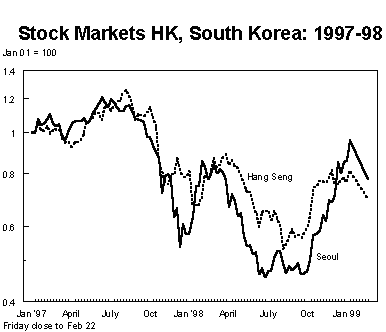
An Unexpected and still Unexplained Crisis
On the eve of the crisis, both Hong Kong and South Korea had been considered
unlikely candidates for the contagion. Only a few months earlier, South Korea
had joined Japan as the second Asian OECD member, and only weeks before, Hong
Kong had successfully completed its merger with China and was riding a wave of
political and business confidence. The IMF had its annual meetings in Hong
Kong a few days before the financial shock erupted-in the form of a massive
speculative attack on the Hong Kong dollar-and in speech after speech had
assured anyone who wanted to listen that the baht crisis would not move
further north.
GDP data a year later shows how erroneous such assurances were. Third
quarter 1998 GDP in both Hong Kong and South Korea was down about 6 percent
from third quarter 1997, the deepest recessions either had recorded since the
1950s. The decline in aggregate output now appears to have ended, at least
in Korea, but a painful adjustment and recovery process continues.
Unemployment rates in both economies have jumped to multi-decade highs, wages
and salaries have declined, and business and consumer confidence has
evaporated. Investment spending has all but collapsed, casting a gloom over
long-term growth prospects.
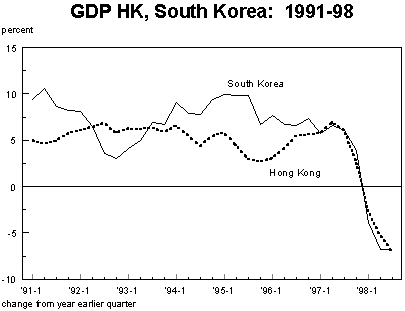
GDP data also shows, to a surprising degree, how similar the aggregate impact of the crisis has been on these two very different economies. A close look at their performances may help to better understand the contagious aspects of the crisis and the effectiveness of their various policy responses. Such a look also casts warnings against overly simplistic explanations regarding the causes and implications of the crisis.
Two Very Different Economies Make Lesson-Drawing Precarious . . .
Just as Southeast Asian economies were quite different from their neighbors to the north, Hong Kong and South Korea, on the eve of the crisis, were probably more remarkable in their differences than their similarities.
- South Korea's economy had been the fastest growing in the world over three decades but had been slowing since 1995. Hong Kong's economy was slower growing over the long period but had accelerated since 1995.
- South Korean stocks and other asset prices had dropped sharply during the 1990s, much like Japan's. On October 1st its main stock index was about 10 percent below its January 1st 1990, hardly an overheated market. Hong Kong's Hang Seng index, in contrast, was four times its January 1990 level.
- South Korea's banking system was widely viewed as weak and poorly managed but in the care of a powerful and fiscally conservative government. Hong Kong's banking system was entirely private and seen as one of the most conservative and best managed in the world.
- South Korea's capital markets were gradually liberalizing, in preparation for full currency convertibility within a few years. Hong Kong's capital markets had long been among the freest in the world, and its dollar was fully convertible.
- South Korean industry was dominated by a few large groups of firms that had overly close ties with the government and with government owned banks. Hong Kong's industry generally had little to do with the government and was often foreign owned.
- South Korea had a flexible though managed exchange rate. The won had declined in value gradually since 1995 in response to a growing trade deficit. Hong Kong's currency had been pegged to a sharply rising US dollar through a currency board mechanism since 1982.
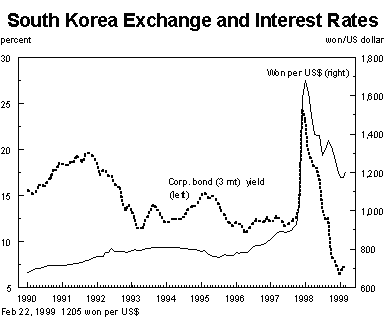
- South Korea, in most years, ran a trade deficit, financed by an inflow of bank borrowings and very little foreign direct investment. At the time of the crisis, this trade deficit was narrowing sharply. For years, Hong Kong's trade account was in close balance with little but with considerable inward and outward foreign direct and portfolio investment.
- South Korea's foreign exchange reserves were small relative to short-term debt. Hong Kong's reserves were huge; Hong Kong dollar bank notes (M1) were 100 percent backed by US dollars as required in the currency board mechanism.
These differences make it difficult to pinpoint the causes of the crisis and to draw lessons for the future. They challenge some of the lessons, below, that are being drawn by international economists and financiers. For instance:
- The dangers of fixed exchange rates. Certainly this has been true for Thailand, Mexico, Russia and most recently, Brazil but Hong Kong's (and China's) fixed rate has been extolled by US and IMF authorities for helping stave off competitive devaluations and South Korea suffered one of the worst exchange rate crises of all despite a floating currency that had been adjusting downward for two years.
- The weakness and lack of transparency of Asian banking systems. This is a good lesson for South Korea, which is making some of the necessary corrections, but Hong Kong's system was considered as sound as any in the world. Its banks have survived intact but the economy, nevertheless, is in tatters.
- The danger of proceeding too fast with capital market liberalization. Again this may be true for South Korea but Hong Kong, if anything, was in danger of moving in the opposite direction, yet it seemed to suffer the same fate.
While not disregarding these lessons, which clearly are useful in explaining issues in individual countries, other factors that do cut across both the South Korean and Hong Kong economies perhaps need be given more prominence. These include:
- Political uncertainty. Both South Korea and Hong Kong were in the midst of major political uncertainty, as were many of the ASEAN countries, Mexico at the time of its crisis, and Russia.
- A slumping Japan and a newly competitive and threatening China. Hong Kong and South Korea both are linked to these problem strewn and giant neighbors. Issues such as Japan's stagnation and the behavior of China's state-owned enterprises are much larger for Hong Kong and South Korean firms then they are for the United States, for example.
- Links to a very strong US dollar. Hong Kong's competitiveness was directly challenged by the appreciation of its own pegged currency. South Korean firms were challenged by their direct and across-the-board competition with Japanese firms that were benefiting as the yen slid dramatically. And Korean firms' large US dollar debts were rising relative to their won earnings.
- The contagious nature of the crisis. Investors, both foreign and domestic, tended to react in concert across the region rather than to discriminate by country and firm. Those who sold their assets have paid for such lack of discrimination-the US dollar value of Korean equity investments is now about four times their year-ago lows-but the negative impact on international capital flows persist.
. . . Yet Macroeconomic Responses Hold True to Theory
Despite difficulties in determining the causes of the crisis, the responses of the Hong Kong and South Korean economies to different policy actions taken by their governments have been predictable. Macroeconomic theory holds that in an open economy, that is absent capital controls and with relatively free trade, a country can either set its exchange rate or its monetary policy, but not both. So in response to a sudden outflow of capital, a country has limited choices: a) it can allow the exchange rate to fall, thus reducing demand for foreign goods while encouraging exports, thus creating a trade surplus that can pay for the capital outflow; b) it can raise interest rates, encouraging people to hold the currency, depresses spending, wages and prices, making domestic goods more competitive to foreign goods and thus, in a more indirect
and usually slower way, creates the same trade effect as an exchange rate depreciation; c) or it can install capital controls which limits the outflow of capital but which also may stop, for many years, the voluntary inflow of foreign capital.
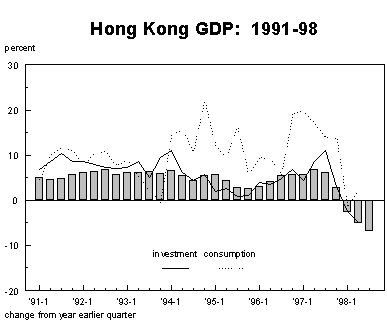
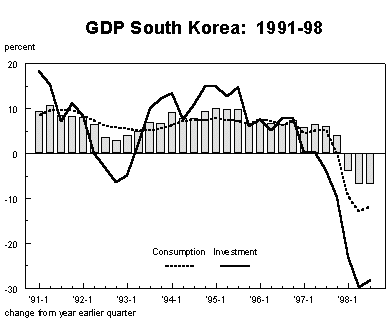
In response to the sudden weakening in demand for Hong Kong dollars in October 1997, and in several episodes of speculative attack since then, Hong Kong, has relied solely on monetary policy to support the exchange rate while engaging in some direct support of the stock market. The fixed exchange rate has held because the authorities have let interest rates and domestic credit policy adjust instantaneously to keep supply and demand for the currency in balance at the pegged
rate.2
- The result has been unsteady interest rates that have shocked the stock market and withdrawal of credit that has shrunk investment. Widespread deflation has and still is occurring, especially in the property market.
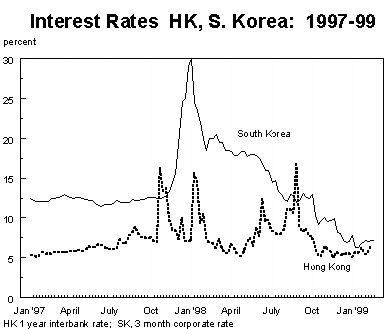
- Investment has plummeted and net exports have contracted, as could be expected given the relative strength of the Hong Kong dollar. Consumer spending has held its own in real terms, aided by declining prices. Since Hong Kong markets are very liberal, wage and price changes tend to have a quick corrective impact on supply and demand.
- With the US dollar and US interest rates falling sharply since October 1998, Hong Kong has benefited with exporters becoming more competitive, local interest rates falling, and stock prices rising.
Facing a more severe form of the same problem by late 1997, and prodded by the IMF which provided emergency credit, Seoul used a much stronger dose of exchange rate and monetary policy to combat its won crisis, allowing adjustment to occur much faster than Hong Kong's through a severe reduction in domestic demand.
- The shock treatment quickly corrected the capital imbalance-perhaps overcorrecting as a huge trade surplus developed within a couple of weeks as imports fell in half. This fall in demand for goods produced outside Korea contributed to the wider contagion affect of the crisis.
- The result has been a huge turnaround in the country's current account balance-from an $8 billion deficit in 1997 to a $40 billion surplus in 1998.
- As Korean demand for foreign exchange fell and as foreign capital slowly began to return, the won appreciated in value and interest rates fell below their pre-crisis levels.
- The stock market continued to fall for nearly a year following the onset of the crisis. In the last few months, however, it has regained all of its losses, aided by the stronger yen/weaker dollar combination that is helping Hong Kong.
US Trade to Recover but Longer Term Growth May Be Difficult
Both Hong Kong and South Korea are important markets for US exports and supply large volumes of US imports. Since Hong Kong's adjustment to the crisis has been to preserve its currency peg to the US dollar, using sharply higher real interest rates and reduced investment spending, the impact on its trade with the United States has been minor, at least up to now. Imports from the US fell 15 percent in the year through
October 1998, while exports rose 2 percent. South Korea's adjustment, in contrast, has included big drops in consumer and investment spending, a rise in domestic savings, and a partially offsetting jump in net exports (a big reduction in imports). Its imports from the United States fell 33 percent in 1998, despite 4 large aircraft deliveries in December, while exports rose 3 percent.
While South Korea has thus contributed in a far more negative way to the growing US trade deficit than has Hong Kong, the prospects for South Korean import growth from this point may be somewhat better.
- Deflation in Hong Kong will gradually improve the economy's competitiveness, weakening the ability of US firms to sell there. Investment driven growth also is likely to be deterred for some time, given recent experience.
- The substantial rise in the won over the past quarter, and the need to replenish stocks of imported goods, should help to encourage Korean consumers to import.
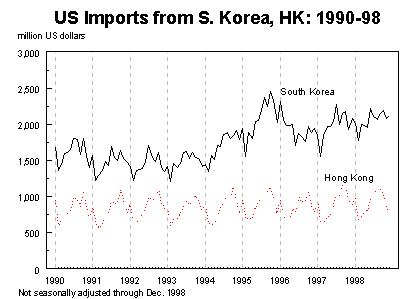
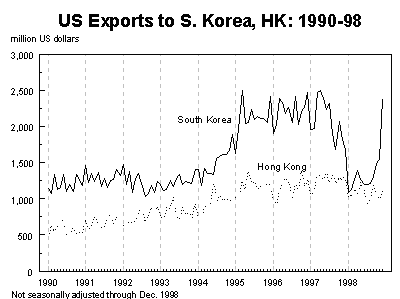
As in Hong Kong, investment growth is unlikely for some time but consumer demand may begin to pick up as confidence in financial markets improves.
Key to improving that confidence, however, is a better understanding of what caused the crisis and assurances that governments and financial institutions are taking measures to prevent a repetition. Until that occurs, Hong Kong will keep a wary eye on monetary developments in the US, China and Japan, as these have a more direct bearing than ever on the city's prosperity. And Koreans are likely to become even stronger savers than they were before the crisis, and their country will likely run a large trade surplus for some years, cutting back on debt.
1. This is a working draft and the
author, William B. Brown, welcomes any comments on the present text. The
views expressed are those of the author and do not necessarily represent those
of the Department of Commerce. Comments can be sent to
william.brown@mail.doc.gov
or by telephone to 202-482-3726
2. The currency board promises to
exchange Hong Kong dollar banknotes at a 7.8 HK$ to 1 US$ rate and, since any
of the three issuers of notes must deposit equivalent US dollars in reserves,
there can never be a shortage of US dollars. There can be a shortage of Hong
Kong banknotes, however, since banks lend many multiples of their banknote
deposits. A run on the Hong Kong dollar thus translates immediately into a
run on bank deposits, forcing banks to call in loans, withhold new credit,
and raise interest rates.
This page last updated 3/24/99 jdb
|







